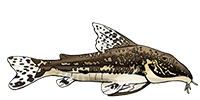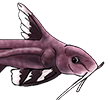I initially started my journey of breeding this beautiful species in April 2024, when I acquired 2 wild adult females from a keeper in Portsmouth. This started my obsession with this species. I found they were extremely fussy with what they ate and often went for a few days without eating the food provided. On May 1st I received an adult male from a seller in Scotland who posted the fish to me. It arrived in terrible shape. It was grey and not looking very active.
A few days later he developed a white fuzz on a few parts on his body, being inexperienced medicating fish and having few medicines to hand I tried both Melafix and Pimafix. Sadly, he did not make it. On the 29th of May I received an order of 3 additional specimens at around 5cm. I was assured at least 1 was male however, all turned out to be female. I continued my hunt for a male over the next month, sadly I had complications with 3 of these smaller specimens which eventually died due to the same white fungus (I have come to realise this is a common issue with wild L183s and something that I personally have not found a cure or prevention for). I managed to acquire a wild pair from a keeper in Cranleigh. With a group of 3 females and 1 male, I felt it was finally possible to breed them. They were put in a 120-litre tank with a Fluval 207 filter. I used a mixture of 2/3 RODI water with 1/3 tap water. I added lots of cattapa leaves, alongside providing a few caves. I noticed the male was not interested in the cave and rather hung on a piece of wood. I was concerned something was wrong with my parameters. I played around using different mixtures of water and even used just tap water, worrying they did not enjoy the RO/DI. I was keeping them at 27°C. I kept looking for more specimens to add to my group as I felt I needed more males as from my extensive research, people usually bred them in pairs. On the 6th of September I acquired a group of 9 wild adults, about 5-6 years old at the time. I counted the rays on each specimen as I had been informed to do by other fish keepers, warning me of potential l181s that are passed off as L183s. I found 3 specimens consisting of 8 soft rays, while the other 6 had 9 soft rays. I decided to remove the 8 soft ray specimens after a brief shape comparison they were slightly different. This left me with a group of 10 specimens. Less than one hour of the new fish being in the tank, the original male was in a cave, something he had not done before.
I decided to go back to my mixture of 2/3 RO/DI water with 1/3 tap water, alongside adding lots of cattapa leaves for tannins. I reduced my heater from 27 to 26 degrees as I thought 27 may have been to high. I did a weekly water change, removing about 20-30%. I used cold RO/DI mixed with warm tap water, additionally, I added some Seachem prime. I tried feeding Repashy soilent green and bug pie and it just rotted in the tank. They seemed to eat algae wafers, however, I soon discovered that I had been over feeding, and the tank started smelling. I decided to upgrade my filter to a Fluval FX4 as well as reducing feeding from 6 algae wafers down to 3-4. Additionally, I fed Dr. Bassleer regular large.
First success
On the 18th of September, I came home from school to find a pair trapping in a water spike on the far-left side of the tank. I had not noticed any change in behaviour apart from the females spending more time near the caves.
I decided to remove the eggs from the cave as I was so excited to raise the fry and watch them grow. I bought a Ziss egg tumbler and put the eggs inside. They lasted about 5 days but sadly the majority fungussed. The fry that did survive were weak and died shortly after.
Second Success
The second spawn occurred on the 1st of October. I woke up to find a clump of eggs rolling around the tank. I believe it was a spawn from my original male. I quickly picked them up and place them in the egg tumbler, this time I added 3 cherry shrimp after reading about how to use an egg tumbler more effectively. This time the majority hatched but they seemed weak.
On the 7th of October they hatched, and I placed them in a Ziss breeder box. It contained cattapa leaves and java moss.
After the egg sack was nearly used up, I started feeding Liquifry No3, as suggested by a local L181 breeder. I noticed that most of it was getting stuck in the java moss and not being accessible for the fry. After a couple days of feeding this, I noticed the fry were lethargic. I saw a Facebook post from Pleco Ceramics, showing how they use their fry paste on a small piece of slate. I decided to try this with Repashy Soilent Green. Almost immediately after adding the slate, painted with a thin layer of Repashy the fry began rasping on the slate. In less than 2 hours all the Repashy had either been eaten or fallen off and fell through the bottom of the breeder box. I decided to keep doing this method, and I painted small pieces of bog wood, slate and cucumber slices. At about 3 weeks old, I started providing a thin slice of cucumber, weighted down by a metal peg. This ensuring the fry had access to it. They started focusing on the cucumber rather than the Repashy so I decided I needed to add something to the Repashy to increase the nutritional value.
Repashy mix
After seeing a Facebook post about feeding chlorella and spirulina I decided to try and mix them into the Repashy. I found the fry only ate the chlorella-Rapashy mix. I used a 2 to 1 part ratio of chlorella to soilent green. This did make it difficult to mix, but adding a bit more water than normal worked well. It stuck to surfaces such as the slate very well and the fry enjoyed it.
Moving the fry
During these 4 weeks, I had another spawn as well as a male being on eggs and needed space for the fry. I decided to move them from the tank with the parents to my green laser Cory tank.
These are the fry on the 28th of October.
I slowly acclimatised the fry before pouring them into the ‘Grow out tank'. I had only 2 tanks at the time, so I had to maximise space.
Grow out tank
Fry after moving to grow out tank
Over the next 5 months, I had another 14 spawns, on average 80 fry were produced. The most spawns I had in one month was 3. It was normally the same male, who inhabited a cave to the far-left side of the aquarium. I noticed they only bred in the water spike caves, rather than traditional pleco caves. I think this is due to the tale tucking the eggs at the back of the cave making him feel comfortable.
Fry tips
I had some ups and downs with raising fry. I noticed if I was to late to provide the Repashy mixture, the fry would become sluggish and eventually die, even if I provided food immediately. I started feeding just before the egg sack was depleted. In the first 2 weeks, I only provided the Repashy mixture. At week 3 a small slice of courgette was also provided. I found only having half a cattapa leaf, forced the fry to rasp of the repashy slate, ensuring they got more food. I did also provide a small piece of bogwood, but if I put another piece of bogwood with the Repashy, I would remove the one with out, ensuring they ate. In the last 5 spawns, I achieved near 100% survival rate of fry using this method. Once they moved to grow out, I fed Dr Bassleer chlorella medium, which they seemed to enjoy. It took about 2-3 months to get them to 3cm. I think this time could be increased by keeping them in a small breeder box rather than another 120ltr tank as it was likely more difficult for them to find food. I found the fry had to go into a well-established aquarium, as they needed biofilm on both plants and wood to survive. I provide courgette and a button mushroom daily to the fry in grow out.
Selling fry
I took 60 3-4cm specimens to a online fish shop. They were put in month old setups, with no substrate, a couple Anubias and no bog wood. Out of the 60 they received, only 28 survived. This was due to the lack of biofilm, as they did not want to eat the dry food provided. When moving fry, I think it is important to tell the recipient of the challenges of feeding these fish, as they are very difficult to feed. After a certain amount of time, they stop eating Repashy and from there it is challenging.
Conclusion
In March of 2025, I sold my breeding group of 10 wild adults, to a local breeder. With over 400 fry currently, I hope to spawn them again, potentially select fry with the white stripe to see if it is possible to achieve a fish which will keep the stripe, even when they get older. This is a species that is difficult to feed and get breeding, but once breeding, can not be stopped. I would suggest the only way to breed them is to acquire a group of at least 5 specimens, but I think more is better.
This is my first breeding report so any suggestion, queries or questions you have I will try to answer. Thanks for reading this




